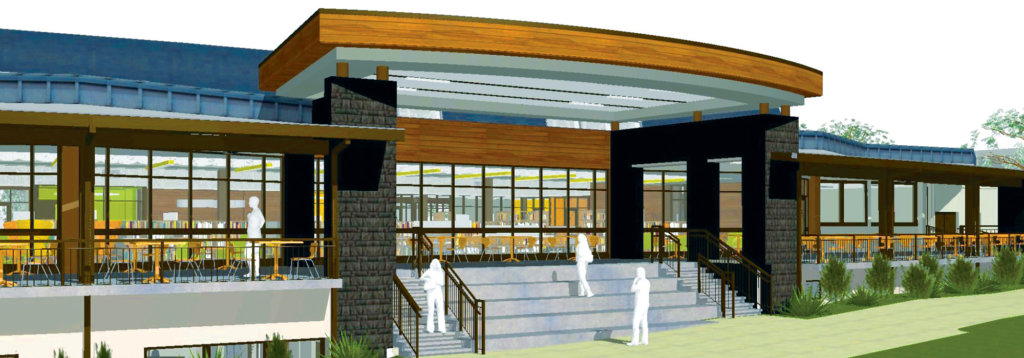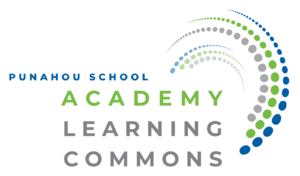Punahou unveils plans to build a new Academy Learning Commons
A dynamic future awaits Punahou’s high school students as the School prepares to build a state-of-the-art, LEED-certified Academy Learning Commons, designed to enhance collaborative, project-based learning and spark imagination at a time when the world has been transformed by technological revolutions and an innovation-driven economy.
This stunning reimagining of Cooke Library into a 21st-century extension of the classroom is envisioned as an intellectual, creative and social hub of the Academy – an inviting space where students will access a broad range of information and materials, collaborate with classmates and teachers on projects, explore virtual reality and augmented reality, experiment with culinary chemistry and food sustainability, and showcase and present their work.
Along with an Emerging Technologies Lab, a Peer Learning Center will provide opportunities for students to mentor each other. Cooke Library’s large collection of books and resources will be housed in modern, sweeping open spaces full of natural lighting. There also will be a new cafe and gathering space, selling grab-and-go food from a kiosk for busy students and faculty in between classes.
Unlike the existing Cooke Library, there will be multiple entrances to amplify the flow throughout the building and truly connect the Academy and Junior School sides of the campus, with grand entrances facing both the Academy Quad and Rice (Middle) Field and additional, smaller side entrances. The new design also includes ample lanai space and covered outdoor seating.
“This new Learning Commons will create opportunities that are beyond our imagination,” said Wendi Kamiya, department chair of the Learning Commons. “We can’t wait to provide students with this future-focused environment.”
Planning for the facility began several years ago and is now in the permitting process. The School hopes to break ground in the summer of 2023 and complete the project in 2025. This is Punahou’s first major building project in the Academy since the opening of the Mamiya Science Center more than two decades ago.
The impetus for reconstructing the existing Cooke Library aligns with Punahou’s core mission to provide students with the skills, resources and inspiration to pursue interests and projects that address real-world issues.
“This new Learning Commons will create opportunities that are beyond our imagination. We can’t wait to provide students with this future-focused environment.”
Wendi Kamiya, department chair of the Learning Commons
“The world into which our students will graduate has changed, and we need to ensure that our educational facilities change with it,” President Mike Latham ’86 said. “As (students) pursue new careers and opportunities in an innovation-based, globally interconnected future, they will need to develop the capacity to collaborate in teams, draw knowledge from multiple fields and use new technologies to frame concrete solutions to authentic, real-world challenges.”
The plan simultaneously advances Punahou’s vision to offer students from kindergarten through grade 12 an interconnected Learning Commons that expand learning beyond traditional classrooms. The K – 8 Junior School Learning Commons, with cutting-edge design labs, art and music spaces and more, was completed as part of the Kosasa Community in 2019, and the Academy Learning Commons will extend this journey through high school.
“The K – 12 Learning Commons continuum is vital to every student’s experience at Punahou,” said Noelehua Lyons ’91 Archambault, Punahou’s vice president for Institutional Advancement. “These all-encompassing environments combine access to a broad spectrum of information, the ability to ideate and physically fabricate solutions, and the arena to present and share student and faculty work broadly with our community. The Learning Commons are designed to be flexible, creating space for the possibility of the yet unimagined.”
Renovating Cooke Library
When Cooke Library was built in 1965, it was hailed for its world-class resources. It’s served the School remarkably well for nearly 60 years, but new educational needs have arisen. For one thing, there aren’t adequate areas where students can work collaboratively, and the Academy lacks space to expand its artificial intelligence instruction.
“The key advantage of the new Learning Commons is the flexibility of the space,” Kamiya said. “When we started this project back in 2014, we determined that flexibility was a high priority, because educational needs are continually changing. The pandemic only heightened this need.”
The new structure will offer various-sized spaces that can be used in multiple ways. These include conference rooms and multiple design studios, including the Emerging Technologies Lab. It will also have open spaces that serve as either group or individual study spaces, along with areas to showcase student art and other creative works. Clubs and student government can hold meetings in the Learning Commons. Students seeking a quiet area for an online college interview could reserve a small room to do so and classmates can meet for academic work or just to unwind together. In short, students will feel at “home” at the Commons.
Despite an overall reimagining, there will still be a library at the core. “You’ll have print books, a library and librarians who help students find books, online information and resources, whether they’re books, e-books or databases,” said Susan Clark, a librarian at Cooke Library.
Right now, the motto at the existing Cooke Library is to make do with what’s there. The building is due for major renovations, including enhancing the electrical infrastructure to support technological needs. Rather than just spend money to make repairs, the School is seizing the opportunity to reconceptualize what’s most needed for students and to support the School’s evolving curriculum.
“Better physical environments greatly enhance learning.” Clark said.
Centers for Emerging Technology
The Emerging Technologies Lab is poised to radically expand the School’s instruction of virtual and augmented reality (VR and AR), by providing a technology-rich place for students to design and create prototypes using artificial intelligence.
“There’s about to be a revolution involving other virtual worlds, and Punahou needs to be on the leading edge of that and teach students how to build out those environments,” said Taryn Loveman, director of Punahou’s Design Technology and Engineering.
Mark Loughridge, director of the School’s Case Accelerator for Student Entrepreneurship, said developments in robotics, software and artificial intelligence, and machine learning could lead to a bigger shift than what took place during the industrial revolution.
“Every industry is going to change as the world embraces these technologies,” he said. “It’s appropriate for Punahou to take a lead in educating students on how to employ these emerging technologies in areas that interest them. You think about Steve Case, who got us on to the internet and democratized it. Now, there’s an opportunity as the internet deepens from 2D to 3D for a new generation of student entrepreneurs and innovators coming out of Punahou to deepen our lives and experiences in immersive areas. It’s a continuation of our story of pioneering.”
Punahou already has developed curriculum to teach emerging technologies, launching an eighth grade VR program and a VR and AR class in the Academy. “These technologies are already changing the curriculum, and that will continue,” Loveman said. “And this new facility is going to be a place that revolutionizes learning and instruction across all content areas.”
The new lab, which provides a continuous bridge to the Academy curriculum from the Junior School, will allow faculty to have a designated space with proper equipment, instead of having to set things up, then take everything down. The existing D. Kenneth Richardson ’48 Learning Lab and the new Kosasa design labs are also scheduled every minute of every day, limiting the type of new instruction that could be offered. “We’re already over capacity, so when we open the new facility, these programs are going to flow into it and fill it instantly,” Loveman said.
Cafe and Gathering Space
The cafe is envisioned as a gathering space designed to foster engagement, collaboration, intersection and connection among students and faculty.
Since his arrival at Punahou three years ago, Mark Noguchi ’93, Punahou’s food curriculum specialist, has been working with faculty across campus to integrate food into the curriculum at all grade levels.
“When you invite people to come on campus and share their skills, students see the connection to why they need to learn things and acquire skills,” he said. “They see what they could accomplish through hard work. I also firmly believe food brings people together and being able to add more culinary opportunities will foster this togetherness.”
Fundraising Begins
Punahou has begun fundraising to support construction of the new Academy Learning Commons, with the Cooke Foundation, Limited leading the way with a pledge of $1 million.
“The Cooke Foundation has a deep and long-term relationship with organizations that our founders helped create, and Punahou is part of our family history,” Cooke Foundation President Greg Wrenn ’86 said.
Trustees of the Cooke Foundation are excited to see how the design reflects progressive approaches to teaching and learning, along with inquiry-based principles. “We love the notion of a Commons where students, faculty and the community interact and think together,” Wrenn added. “It will bring President Latham’s key priorities to life and serve as an important model for the future of education.”

Dynamic Future Ahead
A MESSAGE FROM PRESIDENT MIKE LATHAM ’86

I am very excited to share the news that Punahou will soon embark on a full renovation of Cooke Library to create a dynamic, new Academy Learning Commons. Since its construction in 1965, Cooke Library has served as a wonderful center for teaching and learning. Within its walls, generations of Academy students have developed the essential skills needed to pursue their intellectual interests, thrive in their studies, and gain a greater sense of who they are and what they might accomplish. They have also used it as a sanctuary for quiet reflection, taking full advantage of breaks to study for exams, frame arguments and papers, and strive for a sense of balance among competing demands.
As it was for many Punahou students, Cooke Library became an integral part of my own daily life. As I rose in pre-dawn darkness to commute to campus; spent a full day immersed in classes and labs; raced through my afternoons at cross country and track practices; and finally returned home to eat dinner, prepare for classes and fall into bed, Cooke Library emerged as a precious space where I could pause, study, reflect and think. Walking through its doors, I still feel a deep sense of gratitude to those who envisioned, built and supported it over a half-century ago.
The world into which our students will graduate, however, has changed, and we need to ensure that our educational facilities change with it. While the classic liberal arts abilities to think critically, write clearly and use quantitative reasoning remain essential, we are now preparing students for a world in which they will need to learn, relearn and constantly adapt to new environments. As we pursue new careers and opportunities in an innovation-based, globally interconnected future, they will need to develop the capacity to collaborate in teams, draw knowledge from multiple fields and use new technologies to frame concrete solutions to authentic, real-world challenges, ranging from climate change to food security, elementary education, public health or democratic governance and civil discourse. For many of our students, the question is no longer merely, “what do I want to be when I grow up?” It has also become, “what problems do I most want to help solve?”
Our design and vision for the new Academy Learning Commons reflects those objectives. While the need for quiet study space and library collections certainly remains, the Academy Learning Commons will also support the inquiry-led, project-based learning that has become central to Punahou’s curriculum. Technology-rich spaces will empower our students to work with the tools of virtual reality to build scientific and economic models and to navigate a growing global ocean of data and information. Areas for group work will promote collaboration and the vital exchange of ideas. A cafe and gathering space will create an ideal location for faculty to mentor and advise students outside the classroom and to host events with visiting experts, alumni and community leaders. A grab-and-go lunch space will support busy students as they transition among classes. Gallery spaces will feature student creativity, and our Punahou Archives will provide students with fascinating primary sources, bringing the School’s history to life.
“For many of our students, the question is no longer merely, ‘what do I want to be when I grow up?’ It has also become, ‘what problems do I most want to help solve?’”
President Mike Latham ’86
Our planning has also built on our experience with the Junior School Learning Commons in the new Kosasa Community for Grades 2 – 5. In that project, we aligned our library resources with world-class design and fabrication labs, along with music, art and theatre spaces. This has enabled our students to learn across multiple disciplines. Our third graders, for example, might study Hawaiian history, music and art, and design products together, creating new paths to understanding. In the Academy, we now envision a similar intellectual hub, complementing our existing design and arts facilities with a center for the production and sharing of knowledge.
The first major capital project in the high school since the completion of the Mamiya Science Center in 1999, the Academy Learning Commons will also be an aesthetically compelling space. With wide, open entrances facing Rice (Middle) Field, as well as the Academy quad, it will provide a compelling visual connection to the Junior School. Its large, wrap-around covered lanai will give our students much needed shaded space for their work together. Large, clerestory windows on the main floor will also open the building to appealing natural light.
Each day that I spend in the Academy, I am struck by the tremendous creativity, energy and potential of our students and faculty. Walking across campus, I come upon theatre and Holoku dance rehearsals, chemistry tutoring sessions, soccer practices and debate team strategy sessions. As I teach my Advanced Placement U.S. History course, I am constantly amazed by the curiosity, insights and drive my students display. Our new Learning Commons will be a transformative force for new generations of students and their teachers, enabling them to make the most of their tremendous gifts and to benefit the wider community of which they are a part.
I hope you will share our sense of excitement as we pursue a new phase in Punahou’s long history of innovation. Thank you for your support as we build our School’s future together.






